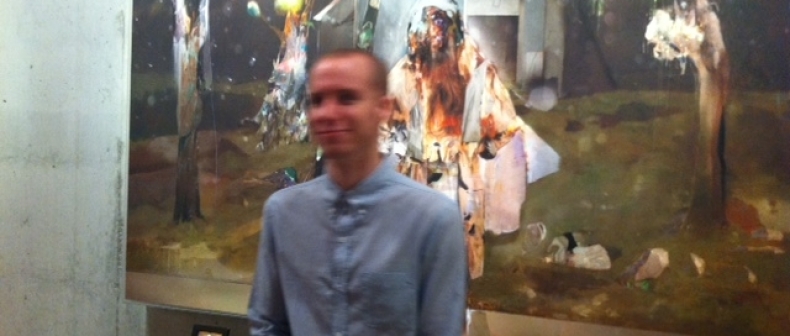
When I first approached Toronto-based artist Alex Fischer and asked him if I could see his studio, we were at the opening for his solo show Beyond The Fall, now at Ossington’s O’Born Contemporary. He looked at me, puzzled. “My studio is my home. My studio is my iMac.” It’s true. His pristine Artscape studio/apartment is small, and perfectly clean. “I’m kind of OCD,” he said, laughing. But it takes a disciplined man to work the way Alex does: entirely in digital, laboriously laying textures.
The world of digital artmaking has a tumultuous reputation. As a newly minted, but still emerging form, it’s confusing for art’s traditionalist minds. Armed with Photoshop rather than a pencil, digital players are making their assault, creating work that is no less serious than that of their painting and sculpture peers, but which doesn’t often get the recognition it deserves. Fischer is a good poster boy for the movement, a charming, optimistic and meandering young man, with a sharp intellect and intense passion. “I went to grad school for a semester, but I didn’t like it. I dropped out. I tried to emphasize that my work existed on the internet as much as in the gallery. But [my panel] always insisted that my work only existed as print.” This ambiguity and evasion of an easy label is attractive to Fischer who even denies calling himself anything other than simply “artist,” despite his digital leanings. “I have a problem with people applying labels to things,” he says.
His multi-sized works are meticulous digital studies, comprised entirely of found images, which he then processes using Photoshop and Corel Paint to create entirely new compositions: “I spend a lot of my time browsing. Basically, I live on the internet. I collect images. I save images. I have 10,000-20,000 images now that I keep in a digital library and I try to keep organized.”
The beauty of digital is that it allows for a diverse visual experience, overtly juxtaposing multiple inspirations and forms. Because it’s new, it’s not formulaic; there is no doctrine or “right way.” Some of Fischer’s pieces are comprised of hundreds of images, while others feature under 10. In his show, there are representational pieces beside works of almost-complete abstract. He prefers it that way. “The beauty of working in digital is that I can split a piece in half, or I can save a piece and work on it 6 months down the line–I don’t have to worry about paint drying. I can work on a piece in several different mind frames.”
His exhibition showcases the far-reaching forms of his work: there are wall-sized landscape prints, both enticing and other-worldly, grotesque and overwhelming. His portraits are sometimes sad, but easily relatable. All interpretations are up to the viewer. “There are specific narratives or themes that I can talk about in my work,” he says. “But people can interpret them however they want.
“For this show, I wanted to touch on all of the things that art history says I’m allowed to touch on as an artist. I can paint whatever I want. I don’t pre-determine what a piece is going to look like before I do it. For example, I may incorporate a person, even when I hadn’t planned to incorporate a person. The narratives and scenes that come out are unpreventable. When I’m working on a piece and it starts to resemble say, particle physics, I’ll do some research on that, and it’ll inform the work.”
Ultimately, his work is a reflection of the changing technological world, and its influence the ways we do things. “I’m trying to make art that has a timeless quality. My work really reflects on the fact that I learned more when I dropped out of school. It’s about being able to self-motivate and look up anything that you want. We have access to so much information. And that’s new–that’s never happened before [in society].”
His portfolio site is just as meticulously organized as his show. And that’s an important facet of his: the internet. He believes its a space that will become increasingly important for the future.
And the future looks bright for Fischer.
“The future? If technology wasn’t so expensive, I would do a lot more. If I could just work on a huge, canvas-sized screen, I would. I would love to work on a giant screen.”
Alex Fischer’s Beyond The Fall is showing at O’Born Contemporary (131 Ossington Ave) until March 10.
____
Jessica Carroll is the Toronto Standard’s editorial assistant. Follow her on Twitter at @jssckr.
For more, follow us on Twitter at @torontostandard, and subscribe to our newsletter.














